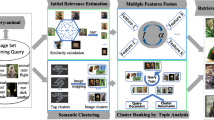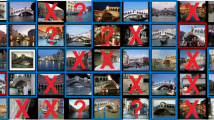Abstract
Image search reranking has received great attention since it overcomes the drawback of “only textual features utilization” in nowadays web-scale image search engines. Most of existing methods focus on relevance reranking, that is reordering the returned results according to their relevance with the query. However, in many cases, users cannot precisely and exhaustively describe their requirements by several query words. Therefore, relevant results with more diversity are more easily meet the users’ ambiguous purpose. To address this problem, in this paper, we proposed a DIR (DDrank-based Image search Rerank) algorithm, which can enrich the topic coverage while keeping the relevance with minimal impact. DIR is based on vertex reinforced random walk and further curbing neighbor items’ growing rate. Therefore, DIR can automatically balance the relevance and diversity of the top ranked vertices in a principle way. Extensive experiments are performed in a popular image dataset, and the results demonstrate the superiority against other existing methods in the criterion of both AP and ADP.
Access this chapter
Tax calculation will be finalised at checkout
Purchases are for personal use only
Preview
Unable to display preview. Download preview PDF.
Similar content being viewed by others
References
Jiao, L., Wang, S., Hou, B.: A Review of SAR Images Understanding and Interpretation. Acta Electronica Sinica 33(12), 2423–2434 (2005)
El Zaart, A., Ziou, D., Wang, S., Jiang, Q.: Segmentation of SAR Images. Pattern Recognit. 35(2), 713–724 (2002)
Ross, T., Worrell, S., Velten, V., Mossing, J., Bryant, M.: Standard SAR ATR Evaluation Experiments Using the MSTAR Public Release Data Set. In: SPIE Conf. on Algorithms for Synthetic Aperture Radar Imagery, vol. 3370, pp. 566–573 (1998)
Chumsamrong, W., Thitimajshima, P., Rangsanseri, Y.: Synthetic Aperture Radar (SAR) Image Segmentation Using a New Modified Fuzzy C-means Algorithm. In: Proceedings of IEEE Symp. Geosci. Remote Sens., Honolulu, pp. 624–626 (2000)
Petrou, M., Matrucceli, A.: On the Stability of Thresholding SAR Images. Pattern Recognit. 31(11), 1791–1796 (1998)
Hua, X., Pierce, L.E., Ulaby, F.T.: SAR Speckle Reduction Using Wavelet Denoising and Markov Random Field Modeling. IEEE Trans. Geosci. Remote Sens. 40(10), 2196–2212 (2002)
Yan, X., Jiao, L., Xu, S.: SAR Image Segmentation Based on Gabor Filters of Adaptive Window in Overcomplete Brushlet Domain. In: Proceedings of Asia-Pacific Conference on Synthetic Aperture Radar, pp. 660–663 (2009)
Weisenseel, R.A., Karl, W.C., Castanon, D.A., Brower, R.C.: MRF-based Algorithms for Segmentation of SAR Images. In: Proceedings of the 1998 International Conference on Image Processing, vol. 3, pp. 770–774 (1998)
Horritt, M.S.: A Statistical Active Contour Model for SAR Image Segmentation. Image and Vision Computing 17, 213–224 (1999)
Kristan, M., Leonardis, A., Skocaj, D.: Multivariate Online Kernel Density Estimation with Gaussian Kernels. Pattern Recognit. 44(10), 2630–2642 (2011)
Ari, C., Aksoy, S., Arkan, O.: Maximum Likelihood Estimation of Gaussian Mixture Models Using Stochastic Search. Pattern Recognit. 45, 2804–2816 (2012)
Kass, M., Witkin, A., Terzopoulos, D.: Snakes: Active Contour Models. Int. J. Compution Vision 1(4), 321–331 (1987)
Peng, R., Wang, X., Lu, Y.: SAR Imagery Segmentation Based on Integrated Active Contour. In: Proceedings of the Int. Conf. on Advanced Computer Control, pp. 43–47 (2010)
Author information
Authors and Affiliations
Editor information
Editors and Affiliations
Rights and permissions
Copyright information
© 2013 Springer-Verlag Berlin Heidelberg
About this paper
Cite this paper
Ji, Z., Li, J., Su, Y., He, Y., Pang, Y. (2013). Balance between Diversity and Relevance for Image Search Results. In: Yang, J., Fang, F., Sun, C. (eds) Intelligent Science and Intelligent Data Engineering. IScIDE 2012. Lecture Notes in Computer Science, vol 7751. Springer, Berlin, Heidelberg. https://doi.org/10.1007/978-3-642-36669-7_67
Download citation
DOI: https://doi.org/10.1007/978-3-642-36669-7_67
Publisher Name: Springer, Berlin, Heidelberg
Print ISBN: 978-3-642-36668-0
Online ISBN: 978-3-642-36669-7
eBook Packages: Computer ScienceComputer Science (R0)




